Bumblebee Nutritional Insights: Health and Sustainability


Intro
Bumblebees have garnered attention recently, not only for their vital role in pollination but also for their potential as a food source. This investigation sheds light on the nutritional value of bumblebees, examining their composition and the advantages they may offer when included in human diets. In a world increasingly focused on sustainability, the idea of consuming bumblebees is becoming more relevant. This section highlights key points that will be discussed, including the nutrients found in bumblebees, their health implications, and their culinary uses. Additionally, cultural perspectives and ecological impacts will be evaluated, providing a well-rounded view of bumblebees as a dietary option.
Recipe Overview
Recipe Name
Bumblebee Stir-Fry
Description of the Dish
This dish utilizes fresh bumblebees incorporated into a vibrant mix of seasonal vegetables and aromatic spices. The result is a unique culinary experience that showcases the delicate flavor of the bees while promoting their nutritional benefits. It is a perfect meal for adventurous eaters seeking to diversify their nutrition and explore sustainable food sources.
Ingredients
- 1 cup bumblebees (cleaned and prepared)
- 1 bell pepper, sliced
- 1 zucchini, sliced
- 1 carrot, julienned
- 2 cloves garlic, minced
- 1 tablespoon olive oil
- Salt and pepper, to taste
- Optional: soy sauce for added flavor
Special Notes on Ingredients
- Bumblebees: Make sure they are sourced from edible suppliers or farms focused on sustainability.
- Vegetable Variations: Feel free to substitute with any seasonal vegetables, such as broccoli or snap peas for added nutrition.
- Flavor Enhancements: A splash of lemon juice or a sprinkle of sesame seeds can enhance the overall flavor profile of the dish.
In this article, we delve into the nutritional benefits of incorporating bumblebees into our diets. The potential health impacts link directly to the rich array of proteins and essential vitamins contained within these insects. As we delve into this topic, it is essential to consider the broader implications for food security and sustainability in the face of a growing global population.
Prologue to Bumblebee Nutrition
Bumblebees hold an intriguing position within the sphere of food resources, particularly in discussions surrounding nutrition and sustainability. As the world seeks alternatives to traditional protein sources, bumblebees emerge not just as an adaptive choice but as a remarkable one, given their unique nutritional profile. Understanding the nutritional value of bumblebees is essential for both consumers and researchers alike.
The interest in bumblebee nutrition is driven by several factors. First, these insects are rich in proteins and essential fatty acids, making them a potential candidate for addressing protein shortages. Second, they contribute to sustainability efforts in food production through their relatively low ecological footprint compared to livestock. Furthermore, including bumblebees in diets can promote biodiversity and a more diversified food system.
Moreover, an exploration of bumblebee consumption delves into various dietary practices across cultures. Historical contexts reveal how certain populations have integrated insects into their cuisines, highlighting bumblebees as a source of vital nutrients. The push towards insect-based diets is not only a culinary exploration but a critical response to global food security challenges.
A comprehensive understanding of bumblebee nutrition involves examining the specific nutrients they provide. This includes a focus on macronutrients such as proteins, fats, and carbohydrates. Additionally, an overview of micronutrients—vitamins, minerals, and amino acids—offers a fuller picture of their health benefits. As discussions around insects in diets continue to grow, addressing misconceptions and providing accurate information becomes increasingly necessary.
In summary, learning about bumblebee nutrition is pertinent for food lovers, nutritionists, and environmental advocates. It underscores the complex relationship between food choices and sustainability, opening avenues for innovative culinary applications. The importance of this topic cannot be overstated, as it influences dietary trends and ecological practices in the years to come.
Nutritional Composition of Bumblebees
Understanding the nutritional composition of bumblebees is crucial for recognizing their role in diets. This section outlines bumblebees' macronutrients and micronutrients. It draws attention to how these elements contribute not only to flavor but to overall health as well. By revealing the significant nutritional aspects of bumblebees, it becomes clear why they should be considered as a viable food source.
Macronutrient Profile
Proteins
Proteins in bumblebees serve as a primary source of essential amino acids necessary for the human body. The composition offers high-quality protein that supports muscle growth and repair. This is especially beneficial for those looking to increase their protein intake without relying solely on traditional animal sources. Bumblebees contain a unique balance of amino acids, which can also aid in healthy metabolism. The digestibility of these proteins allows for greater absorption, which is an advantage in nutrient utilization.
Fats
Fats present in bumblebees are primarily unsaturated fatty acids, which are crucial for heart health. These fats contribute to reducing bad cholesterol levels in the body. Their high concentration of Omega-3 and Omega-6 fatty acids makes them popular among health-conscious individuals. However, it is important to note the need for moderation, as consuming too many fats can lead to excess calorie intake, potentially leading to weight gain if not balanced with overall dietary needs.
Carbohydrates
Carbohydrates in bumblebees are relatively low, making them an attractive option for those on low-carb diets. They mainly provide energy without causing spikes in blood sugar levels, unlike other carbohydrate sources. The unique carbohydrate profile can be supportive for individuals looking to maintain stable energy throughout the day. However, their content may not be significant enough to serve as a sole energy source, emphasizing the importance of including other food types in meals.


Micronutrients Overview
Vitamins
Bumblebees are rich in several vitamins, including B vitamins, which are essential for energy production and brain health. They also contain Vitamin E, known for its antioxidant properties, promoting skin health. The presence of a variety of vitamins supports a balanced nutritional profile, enabling better overall well-being. It is worth noting that the specific levels of each vitamin can fluctuate based on the bumblebee's diet and habitat.
Minerals
Minerals found in bumblebees, such as iron and zinc, play a vital role in numerous bodily functions. Iron is necessary for the formation of red blood cells, while zinc supports immune function. Consuming bumblebees can help fill gaps in mineral intake, particularly for those who may have dietary restrictions that limit other sources. Nonetheless, the mineral concentration may not be sufficient alone, suggesting a diversified diet is still needed for optimal health.
Amino Acids
The amino acids derived from bumblebee consumption add significant value to nutrition, particularly essential amino acids that the body cannot synthesize. These amino acids contribute to various metabolic pathways and further support health and vitality. Their balanced amino acid profile is beneficial for muscle recovery and overall health. However, the unique aspects of amino acids in insects might be less familiar to some consumers, increasing the learning curve in adopting bumblebees in diets.
Caloric Value of Bumblebees
The caloric value of bumblebees serves as an important factor in determining their place in modern diets. Each serving of bumblebees contains a moderate number of calories, making them an excellent choice for those seeking nutritious and less caloric food options. They fit well within the framework of a balanced diet while providing essential nutrients without excessive energy intake. Thus, understanding their caloric content can help in planning meals effectively, integrating bumblebees in a health-conscious manner.
Health Benefits of Bumblebee Consumption
Understanding the health benefits of consuming bumblebees provides important insight into the nutritional profile that can contribute to overall well-being. In a world where food choices are expanding, bumblebees present a sustainable option that offers various health advantages. High-quality protein, essential fatty acids, and immune support are some specific elements that make bumblebee consumption noteworthy. As we explore these benefits, the potential role of bumblebees as a food source is becoming more relevant, particularly in the context of global food security.
Source of High-Quality Protein
Bumblebees are rich in protein, which is an essential macronutrient for human health. Protein is crucial for muscle repair, immune function, and overall cellular health.
The protein found in bumblebees is of high quality. It contains all nine essential amino acids required by the human body. This makes bumblebees an excellent alternative to conventional protein sources like meat or fish, especially for those who are seeking diverse dietary options. Furthermore, the protein digestibility of insects is comparable to that of more familiar sources, offering similar benefits without the environmental costs associated with livestock farming.
This aligns with the growing interest in shifting toward more sustainable dietary practices. In addition to being nutritious, bumblebees can be a lesser-known yet effective addition to a balanced diet.
Rich in Essential Fatty Acids
Beyond protein, bumblebees are also rich in essential fatty acids. These acids are vital for numerous bodily functions including brain health, hormone production, and inflammation regulation. Omega-3 and Omega-6 fatty acids, which are types of essential fats, can be found in significant amounts in bumblebees.
Incorporating sources of these fatty acids into the diet is important for maintaining cardiovascular health and promoting skin health. Furthermore, many people are unaware that bumblebees can provide a nutrient-rich alternative to conventional fatty food sources. Consuming insect protein, such as bumblebees, not only enhances dietary diversity but also contributes to better overall fat intake.
Support for Immune Function
Another notable benefit of bumblebee consumption is their potential to boost immune function. Bumblebees are known to contain various bioactive compounds that can have positive effects on the immune system. Nutrients like zinc, iron, and specific vitamins aid the body in maintaining a robust defense against infections. Antioxidants found in bumblebees may also contribute to reducing inflammation and free radicals in the body.
This aspect of bumblebee nutrition is particularly relevant in today's context where immune health has become paramount. By incorporating nutrient-dense foods like bumblebees into common diets, individuals can potentially strengthen their immunity as part of a holistic approach to health.
Culinary Applications of Bumblebees
Culinary applications of bumblebees present a nuanced exploration of how these insects can be incorporated into various diets. This section emphasizes the growing recognition of edible insects as a viable source of nutrition. Understanding how bumblebees can be used in cooking is important for promoting their consumption and appreciating their nutritional benefits.
Bumblebee in Traditional Cuisines
In many cultures, the consumption of insects is not a novelty but a tradition. Bumblebees, although not the most commonly eaten, have found their place in some traditional dishes. For instance, in certain regions of Mexico, various insect species, including bees and their larvae, are included in local cuisines. These insects are often toasted and used as garnishes or incorporated into sauces, enhancing flavors while also adding nutritional value. The practice underscores a deep connection between local food sources and culture.
Characteristics such as preparation methods and flavor profiles can vary widely. Both historical and contemporary practices show the potential for bumblebees to enrich regional cuisines, providing an alternative protein source while preserving the culinary heritage.
Modern Recipe Innovations
Innovative chefs are beginning to experiment with bumblebees in contemporary cooking. Recipes can range from bumblebee-infused salads to elaborate entrees showcasing whole roasted bumblebees. Their potential to add depth to dishes makes them an attractive ingredient for those interested in novel food experiences.


Furthermore, the emphasis on sustainable food sources has driven interest in insect-based recipes. Bumblebees offer a low-impact alternative compared to traditional livestock.
Creative uses for bumblebees include:
- Bumblebee tacos, where toasted bees add crunch and flavor.
- Sauces made with bumblebee larvae blended for texture.
- Fusion dishes combining Western and indigenous ingredients, highlighting protein diversity.
Potential Pairings
Pairing bumblebees with complementary ingredients can elevate culinary experiences. Their distinct flavor can match well with certain herbs, spices, and vegetables.
Some effective pairings to consider include:
- Citrus fruits: Their acidity can balance the richness of the bumblebee’s flavor.
- Herbs like cilantro and mint: Fresh herbs can enhance the dish without overpowering the primary ingredient.
- Spices such as cumin and paprika: These can add warmth and depth, enhancing the natural flavor of bumblebees.
Experimentation with these pairings can lead to unique and flavorful dishes, appealing to chefs and home cooks alike. Bumblebees not only nourish but also inspire creativity in the kitchen, paving the way for culinary exploration.
"Bumblebees represent a shift in how we think about protein sources, blending tradition with innovation in modern cooking."
Sustainability and Environmental Impact
Insect Farming vs. Traditional Agriculture
The conversation around sustainable food sources increasingly points to insect farming as a viable alternative to traditional agriculture. Insect farming, particularly the rearing of bumblebees, has a lower environmental footprint compared to standard livestock farming. Bumblebees require significantly less land and water for production. For example, the feed conversion efficiency in insects is much higher, meaning that less feed is needed to produce a certain amount of edible biomass. They can thrive on organic waste products, reducing the need for extensive agricultural inputs.
Here are some notable points regarding insect farming using bumblebees:
- Resource Efficiency: Bumblebees can convert feed into body mass more efficiently than conventional animals like cattle or pigs.
- Land Use: Farming insects occupies far less land than traditional animal husbandry, thus helping to preserve natural ecosystems.
- Carbon Emissions: The greenhouse gas emissions associated with insect farming are markedly lower than those from livestock, offering a more climate-friendly option.
- Waste Reduction: Bumblebees can be fed on agricultural by-products that would normally be discarded, contributing to waste management.
Despite these advantages, scaling up insect farming poses challenges. Issues related to consumer acceptance and regulatory frameworks must still be addressed. However, the potential benefits for sustainability cannot be ignored.
Ecological Benefits of Consuming Bumblebees
Eating bumblebees presents a pathway to greater sustainability in food choices. The consumption of insects, including bumblebees, contributes to biodiversity conservation. By promoting edible insects, such practices can lessen reliance on overexploited fish stocks and conventional livestock, which often suffer from overfishing and deforestation.
These key advantages are worthy of consideration:
- Biodiversity: The incorporation of insects into diets can lead to a diversified food system, which is crucial for resilience against climate change.
- Soil Quality: Insect farms do not generally require chemical fertilizers, thereby reducing soil degradation.
- Pest Control: By maintaining ecological balance, bumblebee farming can aid in pest management strategies for various crops.
- Nutrient Recycling: The life cycle of bumblebees helps in nutrient recycling in ecosystems, benefiting wider agricultural systems.
"The shift towards insect consumption, particularly bumblebees, holds promise for addressing food security while ensuring ecological sustainability."
Cultural Perceptions and Acceptance of Edible Insects
The cultural perceptions surrounding edible insects, including bumblebees, play a crucial role in their acceptance as a food source. Understanding these perceptions helps to navigate the challenges of integrating insects into diets that are predominantly composed of more conventional proteins. In many cultures, the consumption of insects is deeply rooted in tradition and has been practiced for centuries. Therefore, examining these cultural factors can reveal insights into both the benefits and obstacles of accepting bumblebees as part of the modern diet.
Consuming insects is not merely a trend; it is an acknowledgment of the nutritional value they offer. As interest in sustainable food sources rises, understanding cultural contexts becomes increasingly important. This article aims to shed light on how cultural significance and acceptance can shape the future of food systems. It is necessary for food lovers to understand that perceptions often dictate choices in consumption, which can, in turn, influence nutritional security globally.
Cultural Significance in Various Regions
In certain regions, insects have long been a staple in the diet, reflecting not only resourcefulness but also deep-seated cultural practices. For instance, in parts of Southeast Asia, bumblebees and other insects are consumed with enthusiasm. They are valued not just for their taste but also for their health benefits. These regions often showcase a variety of dishes that highlight the use of insects, enhancing culinary innovation and biodiversity.
Countries such as Mexico celebrate a variety of edible insects, including bumblebees, in traditional dishes. They serve items like tacos de chapulines and other preparartions that utilize local insect populations. Such traditions foster a greater appreciation and acceptance of insect consumption.
Comparatively, in Western countries, insects are often seen with skepticism. The idea of eating insects, like bumblebees, is not widespread. Educating the public about nutritional benefits and ecological advantages may help to shift these perceptions.
Factors Influencing Acceptance


A multitude of factors affect the acceptance of bumblebees and other edible insects. These can vary greatly based on geography, economics, and societal norms.
- Cultural acceptance: In cultures where insects are traditionally eaten, there is generally less stigma surrounding their consumption. In contrast, societies unfamiliar with this practice may find it difficult to embrace.
- Education and awareness: Familiarity with the nutritional benefits and safety of insects can lead to increased acceptance. Scientific studies showing their high protein content and essential fatty acids may play a pivotal role in changing perceptions.
- Environmental considerations: Growing awareness about sustainability in food production can shift focus towards insect consumption as an eco-friendly alternative. Highlighting the minimal resources required to farm edible insects can further entice consumers.
- Culinary innovation: Creative approaches to cooking with bumblebees can attract interest. Incorporating them into existing favorite recipes can make the transition easier for those hesitant to try.
"Cultural perceptions significantly shape dietary choices, influencing the acceptance of burgeoning food sources like bumblebees."
In summary, embracing edible insects, especially bumblebees, requires a multifaceted approach that considers cultural significance and changing perceptions. By fostering education and awareness about the various benefits, society can potentially reshape dietary habits and integrate these nutrient-dense foods into mainstream consumption.
Safety and Regulations
Understanding the safety and regulations surrounding the consumption of bumblebees is crucial for several reasons. First, ensuring that food products, especially novel ones like edible insects, meet safety standards is essential for public health. This section will explore the parameters that govern the safe consumption of bumblebees, shedding light on food safety standards and the risks that pathogens and contaminants can pose.
Food Safety Standards
Food safety standards for insects, including bumblebees, are implemented to guide producers and consumers. These standards primarily focus on the process of harvesting, processing, and distributing bumblebee products. Several organizations, including the Food and Agriculture Organization (FAO), provide guidelines for insect farming. These guidelines emphasize the importance of maintaining hygienic conditions during the entire lifecycle of the product.
Some key components of food safety standards include:
- Hygiene Practices: Proper cleaning and sanitization are mandatory to avoid microbial contamination. Guidelines often suggest effective cleaning protocols for equipment and workspaces.
- Traceability: Being able to track the source of bumblebees ensures that the products originate from safe and inspected farms. This is significant for managing recalls if any issues arise.
- Labeling Regulations: Clear labeling is required, indicating any potential allergens and nutritional information, so consumers are well informed.
Implementing these standards not only protects consumers but also promotes confidence in bumblebee as a sustainable food source. As consumption grows, it is essential for producers to reinforce these standards to ensure safety.
Pathogens and Contaminants
The discussion about safety and regulations cannot ignore the potential risks posed by pathogens and contaminants found in bumblebees. Insects can be carriers of various pathogens, which, if not properly managed, can pose serious health risks to consumers. Therefore, identifying these risks and how to mitigate them is critical.
Several pathogens that can be of concern include:
- Bacterial Infections: Certain bacteria can thrive in unsanitary conditions. Common pathogens like Salmonella and E. coli could contaminate bumblebees if not properly controlled during farming.
- Chemical Contaminants: Chemicals used in agriculture, such as pesticides, can accumulate in the bodies of bumblebees. Regular monitoring for such contaminants is vital to ensure that the insects are safe for human consumption.
- Parasitic Infections: Some insects can host parasites, which could pose health risks if ingested. Therefore, systematic checks of bumblebee populations are necessary to maintain healthy and safe harvesting.
Future of Bumblebee Consumption
The discussion surrounding bumblebee consumption merits attention due to its multifaceted implications spanning nutrition, sustainability, and cultural acceptance. As global food demand rises, exploring alternative protein sources such as bumblebees can alleviate pressure on traditional livestock. The unique nutritional profile of bumblebees, offering high-quality proteins and essential fatty acids, positions them as a viable option in future diets. This focus on bumblebees also aligns with the growing trend towards sustainable eating, promoting a reduced carbon footprint compared to conventional meat production.
Market Trends and Projections
Market trends indicate a notable shift in consumer preferences toward sustainable and diverse protein sources. As awareness of the ecological benefits of insect consumption increases, bumblebee products may see significant demand. Reports suggest that the market for edible insects could expand rapidly, with projections indicating substantial growth in the next decade.
- Shift Towards Sustainable Choices: Many consumers are prioritizing food choices that minimize environmental impact.
- Diverse Product Lines: Innovations in food processing could lead to bumblebee-based snacks, protein bars, and gourmet meal options.
- Regulatory Support: Increasing government interest may lead to favorable regulations supporting insect farming.
Those elements combine to create a fertile ground for bumblebee consumption to become an integral part of modern diets.
Research and Development
The future of bumblebee consumption is heavily reliant on ongoing research and development efforts. Scientists and food technologists are exploring various aspects of bumblebee production, including nutrition optimization, breeding programs, and farming techniques.
- Nutritional Enhancement: Research aims to enhance the nutrient profile of bumblebees, possibly through their feed.
- Sustainable Farming Practices: Development of environmentally friendly farming practices can mitigate negative ecological impacts.
- Consumer Education: Research initiatives also focus on educating consumers about the benefits of incorporating bumblebees in their diet.
Finale
In this article, we have examined the nutritional value of bumblebees and the implications of consuming them. As we consider the future of food and sustainability, bumblebees emerge as a significant source of nutrition. The rich macronutrient and micronutrient profiles highlight their benefits as a viable food source. Including bumblebees in the diet can provide essential proteins, fats, and vitamins that support health.
The health benefits associated with bumblebee consumption are noteworthy. They offer high-quality protein and essential fatty acids. Furthermore, their role in supporting immune function cannot be overlooked. These factors make bumblebees not only a nutritional powerhouse but also potentially beneficial for overall well-being.
Culinary applications are versatile. Cultures worldwide have integrated insects, including bumblebees, into their traditional cuisines. Their unique profiles can inspire modern recipes, making them a fascinating addition to various meals.
From an environmental perspective, the sustainability of insect farming compared to conventional agriculture is significant. Insects require fewer resources, and embracing bumblebees can help mitigate some ecological issues related to food production.
The considerations regarding safety and regulations are essential. Consumers must be aware of food safety standards and potential contaminants. However, with the right practices, the benefits outweigh the risks.
In summary, the exploration of bumblebee consumption reveals substantial nutritional value, cultural relevance, and ecological benefits. As food systems evolve, bumblebees may play a crucial role in future diets and food security. This nutrient-rich option deserves further research and awareness among food enthusiasts. The journey into edible insects, particularly bumblebees, is only beginning.







